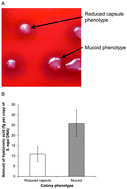Transcriptional changes are involved in phenotype switching in Streptococcus equi subspecies equi†
Abstract
Phenotypic heterogeneity within a population of bacteria, through genetic or transcriptional variation, enables survival and persistence in challenging and changing environments. We report here that a recent clinical isolate of S. equi, strain 1691 (Se1691), yielded a mixture of reduced capsule and mucoid colonies on primary isolation when grown on colistin-oxolinic acid blood agar (COBA) streptococcal selective plates. Passaging colonies of Se1691, with a reduced capsule phenotype maintained this mixed phenotype. In contrast, passaging mucoid colonies fixed the mucoid phenotype, suggesting adaptive genetic or transcriptional changes in response to growth on artificial media. However, despite obvious phenotypic and transcriptional differences, there were no apparent differences in the genome sequences of Se1691 recovered from colonies with a mucoid or reduced capsule phenotype. We identified 105 differentially transcribed genes in the transcriptomes of reduced capsule and mucoid colonies. The reduced capsule phenotype was associated with a significant reduction in transcription of the has locus (SEQ_0269 Q = 0.0015, SEQ_0270 Q = 0.0015, SEQ_0271 Q = 0.0285) and the amount of hyaluronic acid on the surface of S. equi recovered from non-mucoid colonies (P = 0.017). Significant differences in the transcription of 21 surface and secreted proteins were also observed. Our data show that changes in the bacterial transcriptome are linked to the mixed colony phenotype of Se1691.


 Please wait while we load your content...
Please wait while we load your content...